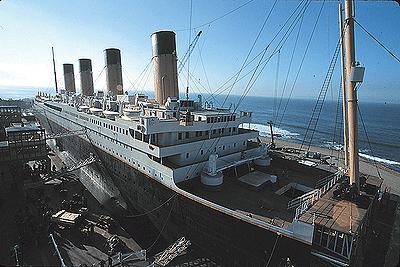InTrans / Aug 24, 2015
Movies in motion: Transportation in Titanic
Go! Magazine
 posted on August 24, 2015
posted on August 24, 2015
In the last article of the series, “Movies in motion: Transportation in Interstellar,” we looked at the “science” of space travel in film. In this article, we’re going to switch gears and look at one of the most famous films set on the ocean—Titanic.
James Cameron—director of famous films like Avatar, Terminator, and Titanic—has a track record for filming popular movies with a big price tag. One of those films, Titanic, is the third most expensive film produced of all time at nearly $294 million. But the money was well spent. Titanic ranks second at the worldwide box office, grossing over $2.2 billion. Not bad for a movie produced in 1997. But what takes the top spot of highest grossing film? That would have to be Cameron’s 2009 computer-generated imagery (CGI) masterpiece Avatar at $2.8 billion.

But what made Titanic so popular? How was all that money spent? Well, let’s just say Cameron did his homework when it came to directing this film.
History of the RMS Titanic
Titanic is based on the shipwreck of the RMS Titanic in April 1912. The RMS Titanic hit an iceberg on its way from Southampton, England to New York. The ship, nicknamed the “unsinkable” because of its size, took with it the lives 1,500 passengers. The loss of life was so great partially because of overcapacity coupled with the lack of lifeboats. The reality was that there were only 20 life boats—only enough to save about 53 percent of those onboard. Additionally, many of the boats were not completely full. During the disaster, one of the RMS Titanic officers thought the order, from Captain Edward Smith, was to load women and children only instead of first. The lack of boats wasn’t due to a lack of space, because the RMS Titanic had been originally designed to accommodate up to 64 boats. The fault lies with the outdated safety regulation and complacency of White Star Line, the ship’s operators.
How Titanic was filmed
Cameron’s fascination with shipwrecks led him to spend part of that $2.2 billion budget on a few deep sea dives where his team filmed the wreckage of the RMS Titanic (See “Exploring the oceans”). According to IMBD, Cameron and his film crew spent more time with the RMS Titanic than the actual passengers did in 1912. This footage made it into the final film.

Cameron made it his mission to really understand the history behind the original shipwreck, and therefore Cameron casted each of the extras (at least 150 of them) with names and back stories of real RMS Titanic passengers. Of course, the main characters Jack (played by Leonardo DiCaprio) and Rose (played by Kate Winslet) were not based on real people aboard the ship—these characters were added as part of the romantic draw of the film.
How did they create and film Titanic?
Imagine building a $23 million dollar facility that you only plan to use for 100 days. Crazy, right? Well, this was the case for Titanic.
In what was called the “100 day studio” located off the coast of Baha, Mexico, crews built two giant water tanks; one was 90 feet by 800 feet (capacity of 17 million gallons), and the other was 30 feet deep (capacity of 5 million gallons). These tanks were used in the sinking scenes initially shown from inside the ship. For instance, the scene where the “Grand Staircase” floods was done in the 5 million gallon tank. That scene only allowed for one shot, because the entire set and furnishings were going to be destroyed after the water was released.
But what about the actual ship? Yes, the constructed ship was made to be intentionally wrecked for the film. The ship, like the original RMS Titanic, was about 60 feet from water to boat deck. Unlike the original, this replica was made to be able to break in half repeatedly, making it a good fit for filming. A huge crane was used to film the overhead shots and long views seen in the film.
The breaking of the ship was recorded in the larger tank, which was supposedly broken in half with the help of a powerful hydraulic jack. The actual sinking of the ship was all thanks to the use of CGI (See “Movies in motion: Transportation in The Matrix and Transformers”). The final scene of the ship sinking with passengers aboard was all digitalized during post-production.
Related links
http://www.titanicandco.com/filmtitanic.html
https://en.wikipedia.org/wiki/Titanic_%281997_film%29
http://news.nationalgeographic.com/news/2012/04/120406-titanic-100-anniversary-bob-ballard-science/
https://answers.yahoo.com/question/index?qid=20110624134905AAlxTEC
http://www.keyflux.com/titanic/facts.htm
http://www.imdb.com/title/tt0120338/trivia
By Jackie Nester, Go! Staff Writer